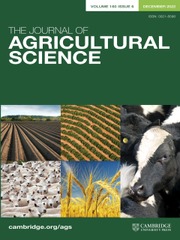Article contents
Methane consumption potential of soybean-wheat, maize-wheat and maize-gram cropping systems under conventional and no-tillage agriculture in a tropical vertisol
Published online by Cambridge University Press: 22 May 2020
Abstract
Methane (CH4) consumption in agricultural soil is imperative for the mitigation of climate change. However, the effect of tillage and cropping systems on CH4 consumption is less studied. Experiments were carried out in Madhya Pradesh, India with soybean-wheat (SW), maize-wheat (MW) and maize-gram (MG) cropping systems under conventional tillage (CT) and no-tillage (NT). Soybean/maize was cultivated during the kharif season (July–October) and wheat/chickpea in the rabi season (October–March) for 9 years consecutively. Soil samples were collected during vegetative growth stages of soybean and maize from different cropping systems. Methane consumption, the abundance of methanotrophs as particulate methane monooxygenase (pmoA) gene copies, soil and crop parameters were estimated. Methane consumption rate was higher in NT and upper soil layer (0–5 cm) than CT and 5–15 cm depth. Methane consumption rate k ranged from 0.35 to 0.56 μg CH4 consumed/g soil/d in the order of MW>SW>MG in 0–5 cm. The abundance of pmoA gene copies ranged from 43 × 104/g soil to 13 × 104/g soil and was highest in MW-NT and lowest in MG-CT. Available nitrogen, phosphorus and potassium were higher in 0–5 cm than in 5–15 cm depth. Soil and plant parameters and abundance of pmoA genes correlated significantly and positively with CH4 consumption rate. No-tillage stimulated CH4 consumption compared to CT irrespective of cropping system and CH4 consumption potential was highest in MW and lowest in MG. However, the magnitude of the positive effect of NT towards CH4 consumption was higher in SW and MG than MW.
Information
- Type
- Climate Change and Agriculture Research Paper
- Information
- Copyright
- Copyright © The Author(s), 2020. Published by Cambridge University Press
References
- 5
- Cited by


